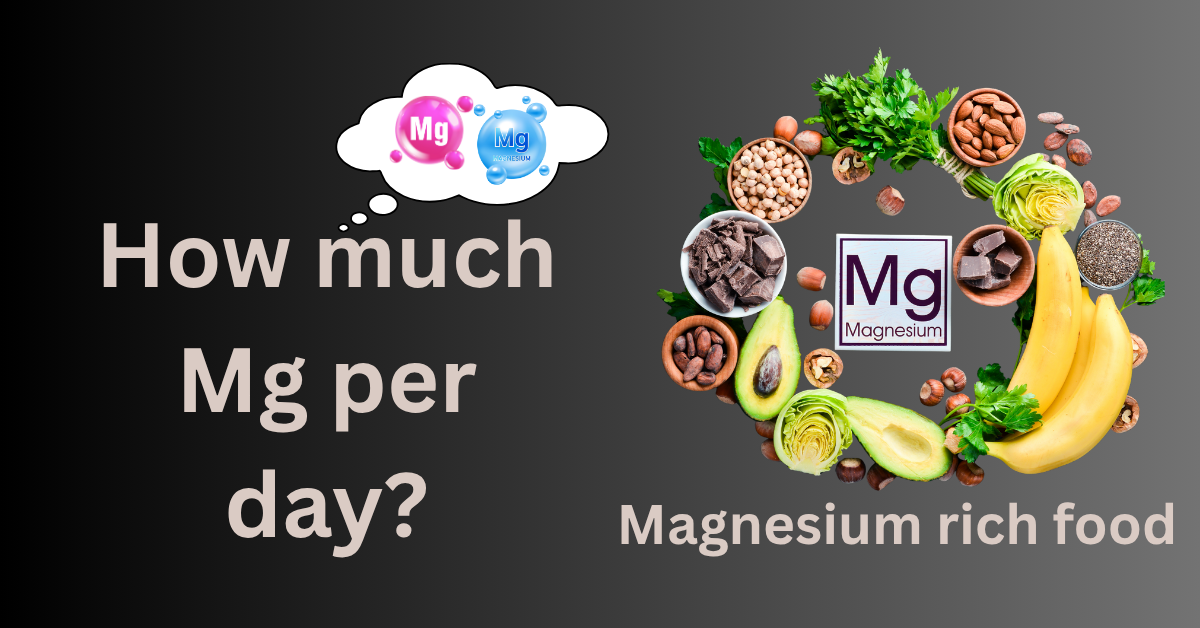How Much Magnesium Per Day does the body need? And top Magnesium-Rich Foods. Yes! This blog will clear doubts about the daily magnesium requirement according to age, food sources, and the magnesium content in them.
Magnesium is a vital mineral for our body, with 60% stored in bones, 25-30% in muscles, and the remaining amount in blood & tissue.
Magnesium plays multiple roles in the body, including strong bone formation, blood pressure regulation, neurotransmission (muscle contraction and relaxation), protein synthesis, energy production, and is crucial in DNA and RNA synthesis.
How Much Magnesium Per Day?
Magnesium dietary allowances vary by age group, and following them is essential to avoid both magnesium deficiency and toxicity.
Table 1: Recommended Dietary Allowances (RDAs) for Magnesium.
| Age | Male | Female | Pregnancy | Lactation |
| Birth to 6 months | 30 mg | 30 mg | ||
| 7–12 months | 75 mg | 75 mg | ||
| 1–3 years | 80 mg | 80 mg | ||
| 4–8 years | 130 mg | 130 mg | ||
| 9–13 years | 240 mg | 240 mg | ||
| 14–18 years | 410 mg | 360 mg | 400 mg | 360 mg |
| 19–30 years | 400 mg | 310 mg | 350 mg | 310 mg |
| 31–50 years | 420 mg | 320 mg | 360 mg | 320 mg |
| 51+ years | 420 mg | 320 mg | ||
Symptoms of Magnesium Deficiency
- Low magnesium level shows loss of appetite, nausea, vomiting, fatigue, and weakness.
- If magnesium deficiency worsens, numbness, tingling, muscle contractions and cramps, seizures, and abnormal heart rhythms can occur.
- Severe magnesium deficiency can result in hypocalcemia or hypokalemia (low serum calcium or potassium levels, respectively) leads to osteoporosis.
Normal Blood Magnesium Level
The normal range for blood magnesium level is 1.7 to 2.2 mg/dL (0.85 to 1.10 mmol/L).
| Parameter | Normal Range |
|---|---|
| Serum magnesium | 1.7 – 2.2 mg/dL (0.7 – 1.0 mmol/L) |
Magnesium-Rich Food
1] Nuts and seeds
- Pumpkin seed
- Cashew
- Sesame seed
- Almonds
- Flex seed
- Chia seed
2] Green leafy Vegetables
- Spinach
- Fenugreek leaves
- Swiss chard
3] Whole grain
- Brown rice
- Quiona
- Oats
- Whole wheat preparation
4] Legumes
- Black beans
- Cheakpeas
- Soyabean
- Sprouted mung dal
- Kidney beans
5] fruit
- Banana
- Figs
- Avocado
- Apple
6] Others
- Chicken breast
- Curd
- Milk
- Salmon
- Beef 90% lean
- Dark chocolate

